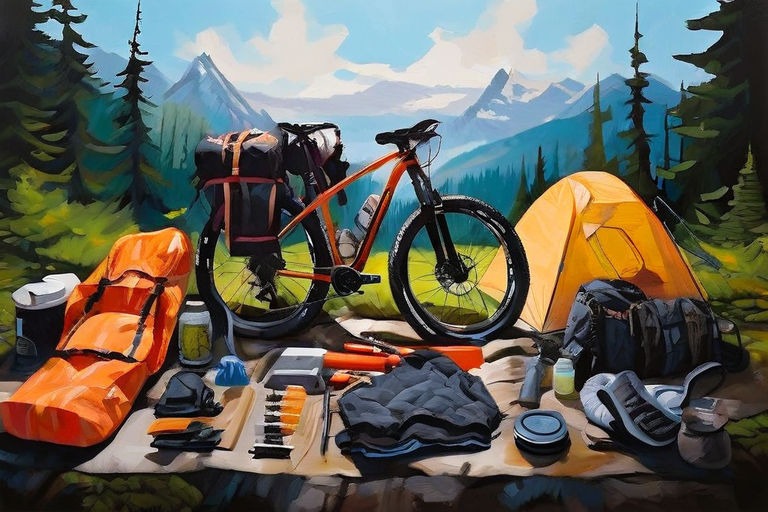What is Bikepacking?
This post contains affiliate links. This means I will make a commission at no extra cost to you should you click through and make a purchase. Read the full disclosure here.
Bikepacking is a unique outdoor activity that combines mountain biking and backpacking. It involves using specially designed bicycle bags and frames to carry gear for multi-day bike trips into remote natural areas. Bikepackers are self-supported explorers who camp while pedalling off-road on their lightweight yet durable mountain or gravel bikes.
The Evolution of Bikepacking
Historical Background
The roots of bikepacking can be traced back to the early 20th century when cyclists began embarking on long-distance tours with minimal gear. However, it wasn’t until the late 2000s that bikepacking gained significant popularity, thanks to advancements in bike technology and the growing interest in outdoor adventures. The rise of social media and online communities also played a crucial role in spreading the word about this exciting activity.
Modern Bikepacking
Today, bikepacking has evolved into a well-defined discipline with specialized gear and equipment. Modern bikepacking bikes are designed to handle rough terrains and carry heavy loads without compromising performance. Additionally, the development of lightweight and durable gear has made it easier for riders to pack efficiently and travel further.

Essential Gear for Bikepacking
Bikepacking Bikes
Choosing the right bike is crucial for a successful bikepacking trip. While any bike can be used for bikepacking, certain features make some bikes more suitable than others. Here are some key considerations:
- Frame Material: Steel, aluminium, and carbon fibre are popular choices. Steel frames are known for their durability and comfort, while aluminium and carbon fibre offer lightweight options.
- Tire Size: Wider tires provide better traction and stability on rough terrains. Many bikepackers prefer tires ranging from 2.1 to 2.4 inches in width.
- Suspension: Hardtail bikes (with front suspension) and full-suspension bikes (with both front and rear suspension) are common choices. Hardtail bikes are lighter and more efficient on smooth trails, while full-suspension bikes offer better control on technical terrains.
Bikepacking Bags
Efficient packing is essential for a successful bikepacking trip. Here are the main types of bikepacking bags:
- Frame Bags: These bags fit within the bike’s main triangle, providing a low centre of gravity and easy access to gear.
- Handlebar Bags: Mounted on the handlebars, these bags are ideal for carrying lightweight and bulky items like sleeping bags and tents.
- Seat Bags: Attached to the seat post and saddle, these bags are great for storing clothing and other lightweight items.
- Top Tube Bags: Positioned on the top tube, these bags offer quick access to snacks, tools, and electronics.
Camping Gear
When it comes to camping gear, lightweight and compact items are essential. Here are some must-have items:
- Tent or Shelter: Ultralight tents, bivy sacks, and hammocks are popular choices.
- Sleeping Bag: Choose a sleeping bag that suits the climate you’ll be riding in.
- Sleeping Pad: A lightweight and compact sleeping pad provides insulation and comfort.
- Cooking Gear: A compact stove, lightweight cookware, and dehydrated meals are ideal for bikepacking.

Planning a Bikepacking Trip
Route Selection
Selecting the right route is crucial for a successful bikepacking adventure. Consider the following factors:
- Terrain: Choose a route that matches your skill level and bike capabilities. Off-road trails, gravel roads, and singletracks are popular choices.
- Distance: Plan a route that suits your fitness level and time constraints. Start with shorter trips and gradually increase the distance as you gain experience.
- Resupply Points: Identify towns, stores, and water sources along the route to ensure you have access to essential supplies.
Navigation
Reliable navigation tools are essential for bikepacking. Here are some options:
- GPS Devices: Dedicated GPS devices offer accurate navigation and are designed to withstand harsh conditions.
- Smartphone Apps: Apps like Komoot, Ride with GPS, and Gaia GPS provide detailed maps and route planning features.
- Paper Maps: Always carry a paper map as a backup in case your electronic devices fail.
Safety Considerations
Safety should be a top priority when planning a bikepacking trip. Here are some tips:
- First Aid Kit: Carry a basic first aid kit and know how to use it.
- Communication: Inform someone about your route and expected return time. Consider carrying a satellite communicator for emergencies.
- Weather: Check the weather forecast and be prepared for changing
Final Thoughts
Bikepacking combines the thrill of cycling with the freedom of camping to provide affordable outdoor adventures.
By strapping gear to their bicycle and striking out on their own, anyone can become an explorer opening up new worlds on two wheels through self-supported journeys across fascinating landscapes.








